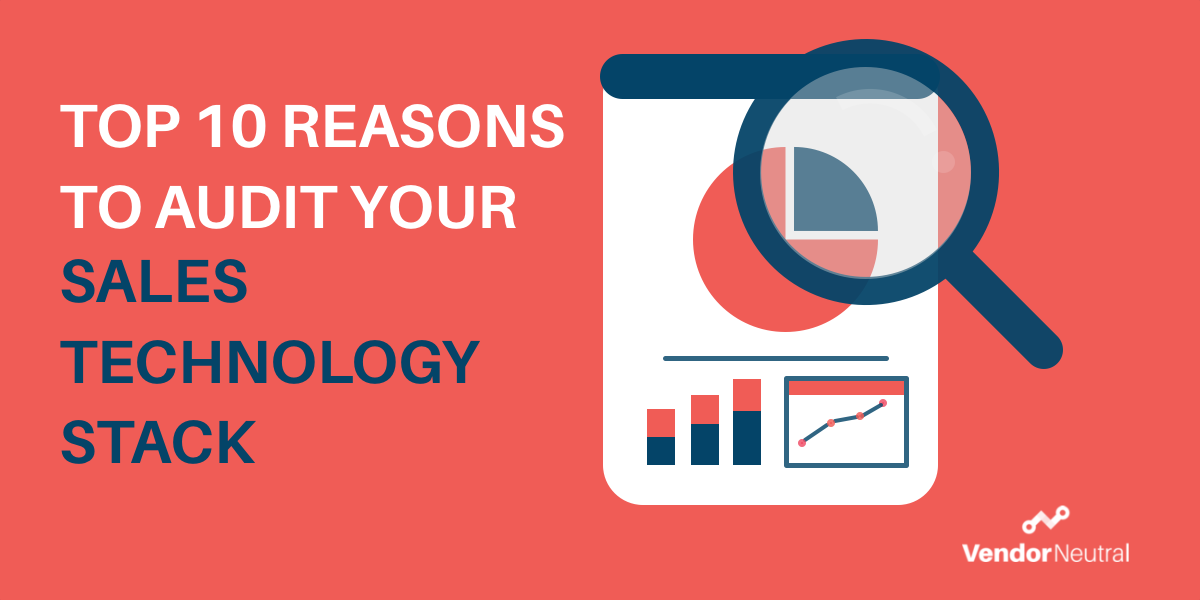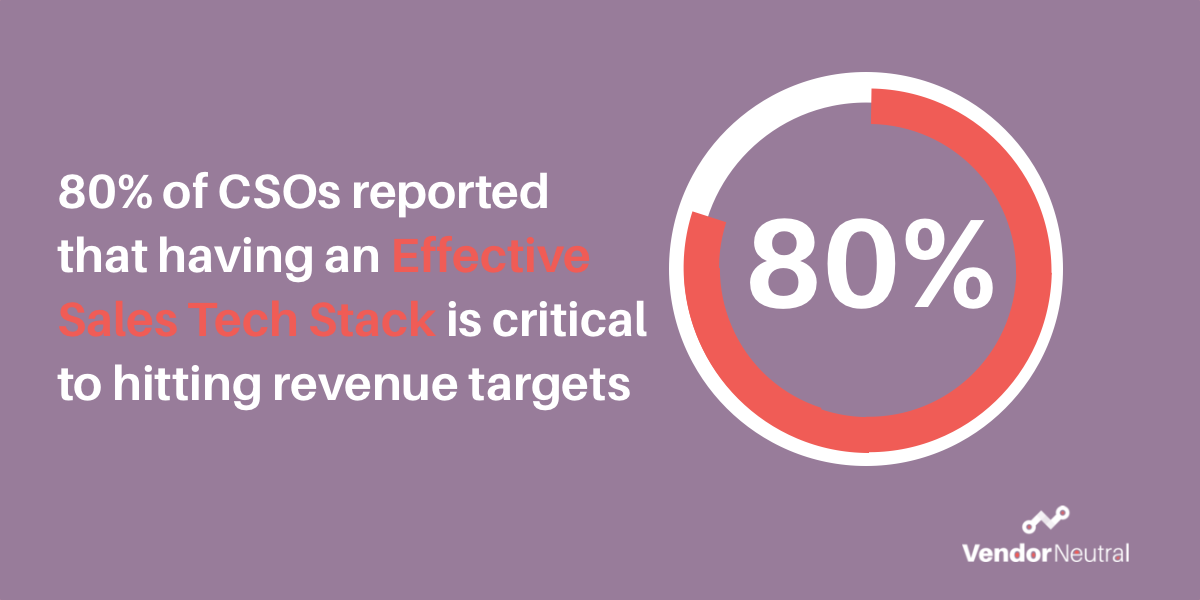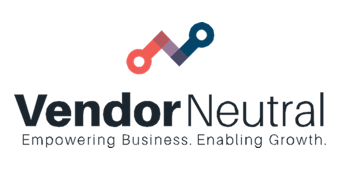The Top 10 Reasons to Audit Your Current Sales Technology Stack

The Top 10 Reasons to Audit Your Current Sales Technology Stack
Sales technology is constantly evolving, and it's easy to end up with a cluttered, misaligned sales stack.
As sales technology experts, we can attest to the fact that the sales technology landscape is constantly evolving and growing. With an abundance of tools available, it’s easy for organizations to end up with a sales technology stack that is cluttered, duplicated, and misaligned with their processes and goals. Research has shown that organizations used an average of 110 SaaS apps in 2021. That’s why regular audits of your sales technology stack are so important.
Why you should consider auditing your sales technology stack
1. To Identify and eliminate any duplicate or unnecessary tools in your technology stack.
According to the 2021 State of SaaSOps Report, the majority of respondents (80%) stated that a portion of their SaaS expenditure is going to waste. To optimize the effectiveness and efficiency of your sales team, it is crucial to identify and eliminate any duplicative or unnecessary tools in your technology stack. A cluttered technology stack can cause confusion and disorganization for your sales team, making it harder for them to access the information they need to close deals. By simplifying your stack and removing any redundant or irrelevant tools, you can improve your team’s productivity by enabling them with a more intuitive and user-friendly interface. This, in turn, allows them to focus on selling instead of navigating through various systems. This approach enhances data quality and improves reporting by reducing data silos and inconsistencies.
"In the 2021 State of SaaSOps Report, the majority of respondents (80%) stated that a portion of their SaaS expenditure is going to waste."
2. To ensure that all the tools in your stack are integrated and working together seamlessly.
Proper integration allows for the automation of data flow and workflows, saving time and reducing errors. This not only improves the efficiency of your sales team but also provides more accurate and actionable data, which can be used to make better business decisions. It also ensures that your sales team can access customer and sales data, regardless of the tool they are using, providing a more complete picture of the customer, which can be used to personalize the customer journey and increase conversions.
Seamless integration of your sales tech stack also allows you to have better control and visibility over your sales process, which can help you identify process/technology bottlenecks and areas for improvement. All of these factors combined can help you to improve your sales team’s performance and increase your overall ROI from your sales technology stack.
3. To identify and address any gaps in your sales tech stack that may be hindering your sales team’s performance.
Gartner research found “80% of CSOs reported that having an effective sales tech stack is critical to hitting revenue targets”. Identifying and addressing any gaps in your sales technology stack is crucial for ensuring that your sales team has the tools and resources they need to perform at their best. Gaps in your stack can manifest in many ways, such as missing features or functionalities, insufficient data, reporting capabilities, or a lack of integration with other systems.
By identifying these gaps, you can take steps to fill them and provide your sales team with the tools and resources they need to be successful. For example, if your current CRM is missing a key feature that your sales team needs to manage leads effectively, consider adding a new tool or upgrading your current one. Or, if your sales team is not getting the insights they need from your analytics tools, you may need to consider adding a new tool or upgrading your current one.
Filling these gaps can significantly improve your sales team’s performance by providing them with the tools and resources they need to be more efficient, effective, and productive. Additionally, by identifying and addressing gaps in your stack, you can also improve the overall quality of your sales data, being used to make better business decisions and optimize your sales process.
Addressing the gaps can also improve the customer experience by providing a more complete picture of the customer, which can be used to personalize the customer journey and increase conversions. Overall, identifying and addressing any gaps in your stack is essential for maximizing the ROI from your sales technology stack and achieving optimal sales performance.

4. To determine which tools provide the most value and which may need to be replaced or upgraded.
Determining which tools in your sales technology stack are providing the most value and which ones may need to be replaced or upgraded is essential for maximizing the ROI from your tools. By evaluating the performance and effectiveness of each tool, you can identify which are delivering the best results and which are not. This information can then be used to make strategic decisions about which tools to continue using, which ones to upgrade, and which to replace.
Reviewing your sales technology also helps you to stay current with the latest technologies and best practices, which can help you stay ahead of the competition. With the constant evolution of the sales technology landscape, it’s important to keep an eye on new tools and features that can improve your sales process and ensure you are using the best tools for your needs.
This review also enables you to pinpoint any inefficiencies or bottlenecks that may be hindering your sales process. Once identified, you can make improvements by replacing or upgrading the tool in question. Continuous optimization measures can lead to significant performance improvements in your sales team, resulting in increased ROI from your sales technology stack.
5. To ensure that your stack is aligned with your overall business goals and strategies.
Aligning your business goals and strategies is crucial for achieving optimal performance and maximizing the ROI from your tools. When your stack is aligned with your business goals and strategies, your sales team can work more effectively and efficiently toward achieving those goals. This includes identifying the necessary tools and functionalities required to support your sales process and the specific data and insights needed to drive better business decisions.
This allows you to better track and measure your sales performance against those goals, enabling you to identify areas where your sales team may be falling short and allowing you to take action to intervene and improve performance. Importantly, it also allows you to better understand your customer’s needs and tailor your sales approach to match them, increasing conversions and improve customer loyalty.
6. To identify opportunities for automation and process improvements.
It is important to emphasize the critical role of automation and process improvements in achieving your goals. Companies can implement automation through the process improvement process to streamline repetitive and time-consuming tasks. Enabling your employees to allocate their time and energy towards more valuable and strategic work increases overall productivity. Automating specific processes can lead to improved accuracy and consistency in their execution, further enhancing efficiency within the organization.
7. To ensure that your sales team is properly trained and utilizing the important features and capabilities of the tools in your tech stack.
Continuous onboarding and training of your sales team on the features and capabilities of your sales tools is crucial for maximizing productivity and efficiency. Well-trained team members are better equipped to use the tools, leading to increased sales and revenue growth. These users can also help you identify and implement process improvements that streamline sales and reduce costs. Enable your team to leverage the features and capabilities that align to your sales process, and you will see greater efficiency and outcomes.
When your sales team is properly trained on the tools, they can quickly and easily access the information they need to make informed decisions about sales strategy, leading to better results in the long run. Continuous training and coaching will help reduce the time spent on administrative tasks and increase the time spent on selling, increasing the team’s overall efficiency. Ensuring that your team is using the most important features and capabilities of the tools in your stack is a crucial step to achieving success in today’s competitive business environment.
8.To identify and address your stack’s compliance or data privacy issues.
By identifying and addressing any compliance or data privacy issues with your sales tech stack, you can ensure that your organization is operating within the bounds of the law and mitigate the risk of costly data breaches and regulatory fines. Additionally, by addressing data privacy issues, you can also build trust with your customers by showing that their data is safe with your organization. It also helps to improve the organization’s reputation and brand image, which is crucial for any business.
it is essential to prioritize compliance and data privacy concerns in your tech stack. You need to ensure your organization is operating lawfully and safeguarding against costly data breaches and regulatory penalties. Addressing these issues not only helps your organization avoid legal and financial repercussions but also fosters customer trust through your commitment to protect their data.
Failing to prioritize data privacy and compliance can result in reputational damage, loss of customer trust, and potential legal action, making it even more crucial to address these issues proactively. Addressing these concerns heps your business establish credibility and a reputation as trustworthy and secure.
9. To ensure that your stack can provide accurate and actionable data and insights.
Precise and applicable data and insights are fundamental to the decision-making process that drives sales and revenue growth. Accurate data can provide valuable insights into customer behavior, help identify trends, and enable data-driven decision-making. With access to such data, sales teams can effectively identify and prioritize leads, ensuring optimal utilization of time and resources.
Actionable data and insights aid in understanding the sales process’s effectiveness, facilitating the identification of areas for improvement. This data can lead to the optimization of the sales process and increased team efficiency. Helping to identify the best-performing products and channels and enabling businesses to replicate their success.
Recent studies have shown that a significant number of sales representatives, approximately 57%, fail to accurately forecast their pipeline. The identification and integration of sales tech can aid in forecasting sales and enable more accurate budgeting decisions. It is vital to ensure that the tools in your sales tech stack can provide precise and relevant data and insights. This way, your organization can make informed and data-driven decisions that will boost sales and revenue growth and achieve optimal performance.
10. To stay current with the latest technologies and best practices in sales technology and stay ahead of the competition.
Staying current with the Sales Technology Landscape and best practices in sales technology is crucial for staying ahead of the competition in today’s fast-paced business environment. Sales Technology is constantly evolving with new tools and strategies that can help your organization drive sales and revenue growth. Stay current so that your organization can gain a competitive advantage by leveraging new sales tools and strategies before your competitors do.
"We understand that conducting a thorough sales technology audit can be a daunting task. That's why we're here to help."
Staying current with the latest technologies and best practices can also help to improve the overall efficiency and effectiveness of the user’s workflow and sales process. For example, new technologies such as Artificial Intelligence and Machine learning can automate repetitive tasks and provide insights that can help to improve the sales process. Incorporating industry-leading methodologies into critical functions such as customer relationship management and lead generation can significantly enhance their efficiency and yield superior outcomes.
Auditing your sales technology stack is a crucial step in maximizing your return on investment. You can optimize your processes and improve your overall sales performance by identifying inefficiencies, redundancies, and gaps in your technology. Remember to take a comprehensive approach to your audit, considering all aspects of your sales technology stack, from your CRM and marketing automation tools to your sales enablement and analytics software.
At Vendor Neutral, we understand that conducting a thorough sales technology audit can be a daunting task. That’s why we’re here to help. Our team of experts has the experience and knowledge to assist you in assessing your existing technology stack and identifying areas for improvement. We can help you develop a tailored plan to optimize your technology and achieve the best possible results.
Don’t wait to unlock the full potential of your sales technology stack. Reach out to us today, and let us help you take your sales performance to the next level. Contact us now to schedule a consultation with one of our experts.



